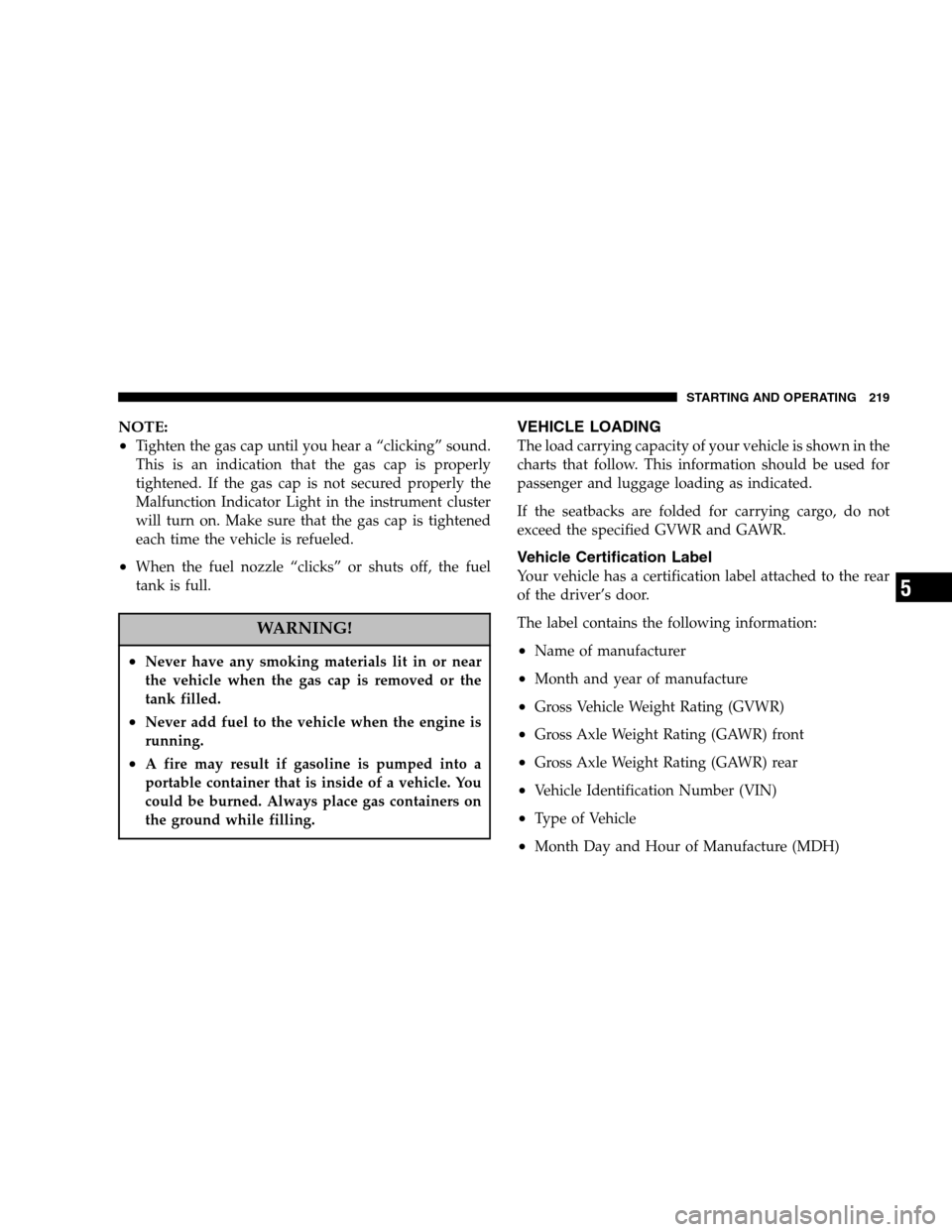Page 216 of 320

content of gasoline may not be indicated on the pump,
you should ask your gasoline retailer whether or not
his/her gasoline contains MMT.
It is even more important to look for gasolines without
MMT in Canada, because MMT can be used at levels
higher than those allowed in the United States.
MMT is prohibited in Federal and California reformu-
lated gasolines.
Materials Added to Fuel
All gasoline sold in the United States is required to
contain effective detergent additives. Use of additional
detergents or other additives are not needed under
normal conditions and would result in additional cost.
Therefore you should not have to add anything to the
fuel.
Fuel System Cautions
CAUTION!
Follow these guidelines to maintain your vehicle’s
performance:
•The use of leaded gas is prohibited by Federal law.
Using leaded gasoline can impair engine performance,
or damage the emission control system.
•An out-of-tune engine, or certain fuel or ignition
malfunctions, can cause the catalytic converter to
overheat. If you notice a pungent burning odor or
some light smoke, your engine may be out-of-tune or
malfunctioning and may require immediate service.
Contact your dealer for service assistance.
•The use of fuel additives which are now being sold as
octane enhancers are not recommended. Most of these
products contain high concentrations of methanol.
216 STARTING AND OPERATING
Page 219 of 320

NOTE:
•
Tighten the gas cap until you hear a “clicking” sound.
This is an indication that the gas cap is properly
tightened. If the gas cap is not secured properly the
Malfunction Indicator Light in the instrument cluster
will turn on. Make sure that the gas cap is tightened
each time the vehicle is refueled.
•When the fuel nozzle “clicks” or shuts off, the fuel
tank is full.
WARNING!
•Never have any smoking materials lit in or near
the vehicle when the gas cap is removed or the
tank filled.
•Never add fuel to the vehicle when the engine is
running.
•A fire may result if gasoline is pumped into a
portable container that is inside of a vehicle. You
could be burned. Always place gas containers on
the ground while filling.
VEHICLE LOADING
The load carrying capacity of your vehicle is shown in the
charts that follow. This information should be used for
passenger and luggage loading as indicated.
If the seatbacks are folded for carrying cargo, do not
exceed the specified GVWR and GAWR.
Vehicle Certification Label
Your vehicle has a certification label attached to the rear
of the driver’s door.
The label contains the following information:
•Name of manufacturer
•Month and year of manufacture
•Gross Vehicle Weight Rating (GVWR)
•Gross Axle Weight Rating (GAWR) front
•Gross Axle Weight Rating (GAWR) rear
•Vehicle Identification Number (VIN)
•Type of Vehicle
•Month Day and Hour of Manufacture (MDH)
STARTING AND OPERATING 219
5
Page 267 of 320
Cavity Fuse Circuits
4 40 Amp Green Battery
5 30 Amp Pink Heated Seat/Steering
Column
6 20 Amp Yellow Fuel Pump
7— —
8 15 Amp Dk.
BlueIgnition Start/Run - Start
9 20 Amp Yellow Console Power Outlet
10 10 Amp Red Rear Fog Lamp — If
Equipped
11 25 Amp
C/BRKRMemory Module/Door
Locks
12 25 Amp
C/BRKRPassenger Power Seat
13 30 Amp
C/BRKRDoor Module Run/Acc/
Delay
14 10 Amp Red Sentry Key/Remote Key-
less Entry/Cluster
15 — —
16 — —
17 — —Cavity Fuse Circuits
18 20 Amp Yellow Selectable Power Outlet
19 10 Amp Red Stop Lamp
20 — —
21 — —
22 — —
23 — —
24 — —
25 — —
26 — —
27 10 Amp Red Airbag/Occupant Classi-
fication Module
28 10 Amp Red Curtain Airbag - if
equipped
29 5 Amp Orange Sentry Key/Remote Key-
less Entry/Powertrain
Control Module Ignition
Feed
30 10 Amp Red Steering Column
Module/Power Mirrors
31 — —
MAINTAINING YOUR VEHICLE 267
7